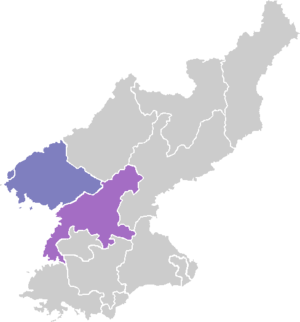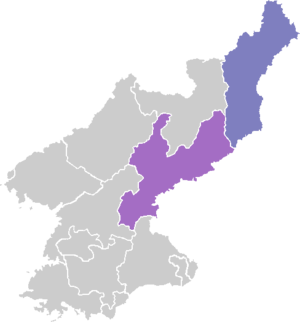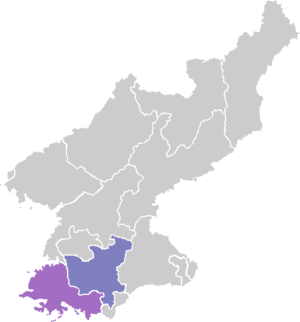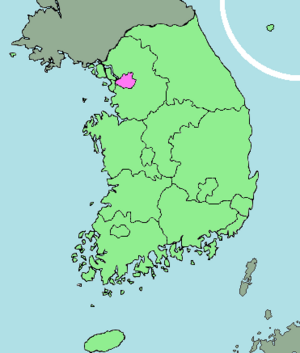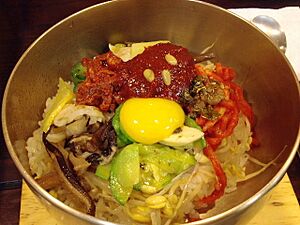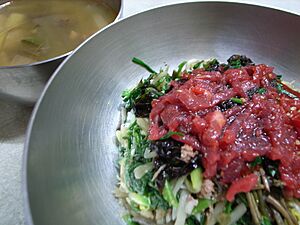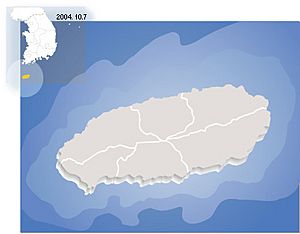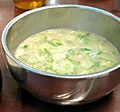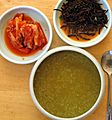Korean regional cuisine facts for kids
Quick facts for kids South Korean name |
|
| Hangul |
향토요리
|
|---|---|
| Hanja |
鄕土料理
|
| Revised Romanization | hyangto yori |
| McCune–Reischauer | hyangt'o yori |
| IPA | [hjaŋ.tʰo.jo.ɾi] |
| North Korean name | |
| Chosŏn'gŭl |
향토료리
|
|---|---|
| Hancha |
鄕土料理
|
| Revised Romanization | hyangto ryori |
| McCune–Reischauer | hyangt'o ryori |
| IPA | [hjaŋ.tʰo.ɾjo.ɾi] |
Korean regional cuisines are special dishes and cooking styles found in different parts of Korea. These unique foods developed over time in various provinces. Each area had its own way of cooking and its own favorite ingredients.
Even though Korea is now split into North Korea and South Korea, it used to be divided into eight main provinces during the Joseon Dynasty. These provinces were: Hamgyeong, Pyeongan, Hwanghae in the north; Gyeonggi, Chungcheong, and Gangwon in the middle; and Gyeongsang and Jeolla in the south.
For a long time, travel was difficult, so each province kept its own special tastes and cooking methods. The food also depended on the local climate and what crops or natural foods were available. Today, with better transportation, Korean regional foods sometimes mix. But many unique traditional dishes are still passed down through families.
Contents
Northern Region: Discovering North Korean Flavors
Pyongan Province: Big Dishes and Cold Noodles
Pyongan cuisine comes from Pyongan province. It's known for large portions, making meals look plentiful. A common dish is jobap, which is steamed rice mixed with millet. Noodle dishes like naengmyeon (cold buckwheat noodles) and mandu (dumplings) are very popular.
The food here is usually mild in taste. People enjoy fatty foods in winter. Dongchimi, a watery kimchi, is often eaten. It's also used as a broth for naengmyeon.
Some famous Pyongan dishes include gukbap (soup with rice) and Pyongyang naengmyeon. Pyongyang manduguk (Pyongyang style dumpling soup) is another favorite.
Tteok (rice cakes) from Pyongan are often larger and simpler than those from Seoul. One example is songgi tteok, made with pine tree bark. Notti is another special rice cake, made from pounded millet flour and pan-fried.
Pyongyang: The Capital's Cool Cuisine
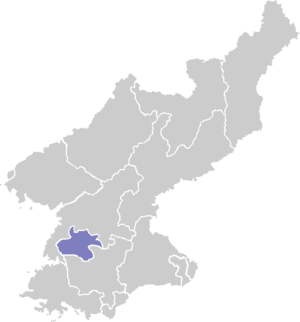
Pyongyang is North Korea's capital. Its food shares many traits with Pyongan cuisine. The most famous dish is Pyongyang naengmyeon. This "cold noodle" dish is served in a chilled broth, often with meat broth and dongchimi. It's topped with a slice of Korean pear. People used to eat it in winter, even though it's cold!
Another special Pyongyang dish is Taedonggang sungeoguk, or "trout soup from the Taedong River". It's made with fresh trout from the river. This soup is often served to important guests.
Pyongyang onban is another local favorite. It's warm rice topped with mushrooms, chicken, and bindaetteok (mung bean pancakes).
Hamgyong Province: Spicy and Hearty Dishes
Hamgyong province is in the far north of Korea. It has mountains and faces the Sea of Japan. Many grains like millet, sorghum, and soybeans grow well here. Potatoes are also common. The sea provides fresh fish, especially Alaska pollock.
Hamgyong food isn't too salty, but it uses lots of garlic and chili pepper. The spicy sauce called dadegi comes from this region. Hamhung naengmyeon is a cold noodle dish made with this spicy sauce. It's topped with hoe (sliced raw fish) and mixed with the sauce. This makes it different from other naengmyeon dishes.
Typical Hamgyong main dishes include japgokbap (mixed grains) and dak bibimbap (mixed rice with chicken). Garitguk is a beef short rib soup with raw seasoned beef. Besides Hamhung naengmyeon, gamja guksu (potato noodles) are also popular.
Chagang and Ryanggang Provinces: Potato Power and Unique Kimchi
Ryanggang and Chagang provinces are mountainous and share a border with China. Because Napa cabbage doesn't grow well here, people use Indian mustard leaves, called gat, for kimchi. Gat kimchi is famous in these provinces. It has a fresh, aromatic flavor and stays good for a long time.
Potatoes are very common here, with about 80 different potato dishes! Some examples are gamja nongmal guksu (potato starch noodles) and gamja tteok (potato rice cake). These potato starch noodles are very chewy. They are served with various toppings and a separate broth.
Susutteok is a special rice cake from Chagang province. It's made with local sorghum, corn, and beans. People eat it with kimchi and namul (sautéed mountain vegetables).
Central Region: Diverse Tastes and Traditions
Hwanghae Province: Grain Basket and Simple Flavors
Hwanghae province is known for its excellent grain production, especially millet. The millet here is thick and tasty. This abundance of grains also means good quality meat. Chicken is often used in dishes like noodles and dumplings.
The coastal area near the Yellow Sea produces a lot of salt. Kimchi from Hwanghae has a clear, refreshing taste. Its brine is often used as a soup. For example, dongchimi brine is used for naengmyeon or mixed with chilled rice for a snack. Hwanghae dishes are savory and simple, with less fancy decoration. Dumplings are made larger than in other regions. The taste is balanced, similar to Chungcheong province.
The most famous Hwanghae dish is Haeju bibimbap from Haeju. It's fried rice with chopped pork, various namul, and sliced chicken. It uses black soy sauce instead of Gochujang. Other main dishes include japgokbap (various steamed grains) and kimchibap (steamed rice with kimchi).
Gangwon Province: Mountain and Sea Delights
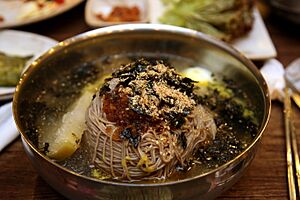
Gangwon cuisine is simple and plain. It features dishes made from potatoes, corn, buckwheat, and seafood. Main dishes often include Chuncheon dakgalbi (spicy stir-fried chicken), gangnaengi bap (steamed corn and rice), and makguksu (buckwheat noodles).
Gamja ongsimi (potato dumpling soup) and gamja beombeok (mashed boiled potato with grains) are also popular. Seafood dishes like ojingeo sundae (squid stuffed with various ingredients) are enjoyed along the coast.
Kaesong: Royal and Refined Cuisine
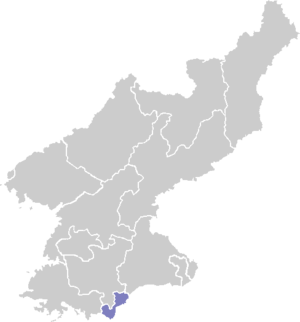
Kaesong was the capital of Goryeo for nearly 500 years. Because of this, its food culture became very advanced and luxurious. Kaesong cuisine is often compared to the fancy food of Seoul and Jeolla. It used to be part of Gyeonggi cuisine but became part of North Korea after the Korean War.
Famous Kaesong dishes include Bossam kimchi (wrapped kimchi), pyeonsu (square summer dumplings), and sinseollo (royal casserole). Joraengi tteokguk (dumpling soup) and umegi (rice cakes covered with syrup) are also special. Umegi, also called Kaesong juak, is a sweet and delicate holiday food. It's made by frying rice flour balls and coating them in syrup.
Gyeonggi Province: Balanced Flavors and Grain Dishes
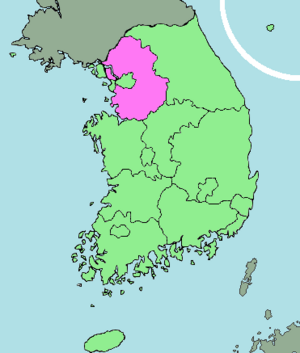
Gyeonggi province is in the middle of the Korean peninsula. It has mountains around Seoul and seafood from the Yellow Sea. Jeotgal (fermented salted seafood) is common here, especially jogijeot (croaker) and saeujeot (small shrimp). These are often used in kimchi.
The climate is mild, so many grains are grown. Dishes made with grains are very popular, like Ogokbap (steamed five cereal crops) and chalbap (steamed glutinous rice). Gyeonggi cuisine is generally simple, with moderate flavors and seasonings, except for the more luxurious Kaesong dishes.
Savory grain dishes include sujebi (dumpling soup) and beombeok (thick mixed-grain porridge). Noodle soups like Jemul guksu (noodles in soybean paste soup) have thick, savory broths. Naengkongguk (cold soybean soup with dumplings) is also a common dish.
Seoul: The Capital's Elegant Cuisine
Food in Seoul, the capital city, is known for being fancy and carefully prepared. Meals are served in small portions with many different dishes. They use many seasonings, but the taste is not too spicy.
Some popular main dishes are seolleongtang (beef soup with rice) and tteokguk (rice cake soup). Heukimjajuk (black sesame porridge) and jatjuk (pine nut porridge) are also enjoyed. Seolleongtang is especially famous. It's said to have started from a ritual where kings prayed for good harvests, and everyone shared a large beef soup.
Seoul cuisine features royal dishes like sinseollo (royal casserole) and Gujeolpan (nine-sectioned plate). These dishes show off the elegant style of Seoul food. Braised dishes like galbijjim (braised short ribs) and stir-fried tteokbokki are also common.
Many types of tteok (rice cakes) are made in Seoul, often with high-quality ingredients and a lot of effort. Examples include danja, which are small, decorated rice balls, and hwajeon, made with flower petals.
Traditional Korean sweets, called hangwa, are also popular. These include yakgwa (fried honeyed pastries) and maejakgwa (crispy ribbon-shaped pastries). Dasik are patterned cakes eaten with tea.
Seoul cuisine also has many refreshing hwachae (fruit punches) and various teas. Hwachae can be made with fruits, flowers, or grains. Teas are made from fruits like yujacha (citron tea) or herbs like ginger and cinnamon.
Chungcheong Province: Simple and Hearty Meals
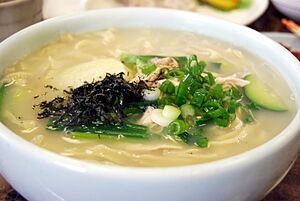
Chungcheong province includes both landlocked areas and coastal regions facing the Yellow Sea. Most people here work in farming. The Yedang Plain provides many grains. The Yellow Sea offers good fishing.
During the ancient Three Kingdoms period, rice was likely the main grain for the Baekje kingdom, which was in this area. Chungcheong cuisine is known for its simple, honest flavors.
Popular dishes include kalguksu (knife-cut noodle soup) and various stews. Yukhoe (raw seasoned beef) and jeyuk bokkeum (stir-fried pork in chili paste) are also enjoyed. Pat sirutteok (steamed rice cake with red beans) is a common rice cake.
Southern Region: Rich Flavors and Seafood Focus
Jeolla Province: Rich and Luxurious Cuisine
The food from Jeolla province in the southwest is famous for being very rich and fancy. It's often compared to the luxurious food of Kaesong. While Kaesong food kept old traditions, Jeolla cuisine developed its own unique style from the noble families of the Joseon Dynasty.
The Honam Plain in Jeolla is very fertile, producing lots of rice. The Yellow Sea and East China Sea nearby provide a wide variety of seafood.
Jeonju bibimbap (mixed rice with vegetables) is a very famous dish from this region. Samhap (three combination) is another unique dish, featuring cooked pork, kimchi, and fermented raw fish. Seafood dishes like Hongeohoe chomuchim (fermented fish seasoned with spicy sauce) are also popular. Sujeonggwa (persimmon punch) is a refreshing drink.
Gyeongsang Province: Spicy Seafood Delights
Gyeongsang province borders the Sea of Japan and the East China Sea. Fish is a very important food here. Seafood is cooked in many ways, and hoe (raw sliced seafood) is considered a special treat. Soups made with fresh fish are common, unlike in landlocked areas.
Myeolchi jeot (fermented salted anchovies) is a widely used fermented seafood. Gyeongsang cuisine is simple but uses many seasonings, making it saltier and spicier than Jeolla food. Noodles are very popular, often made with raw soybean powder.
Andong, a city known for its old traditions, has many local specialties. These include Andong jjimdak (braised chicken), heotjesabap (a special mixed rice dish), Andong soju (a traditional liquor), and salted mackerel.
Jeju Island: Simple Island Flavors
Jeju Island is the largest island south of the Korean peninsula. Because it doesn't have much fresh water, rice farming is small-scale. Instead, people grow grains like millet, buckwheat, and barley.
A traditional Jeju meal usually includes japgokbap (steamed mixed grains) as the main dish. Side dishes often feature salted dried fish called jaban. Soups made with doenjang (soybean paste) are common, like baechuguk (Napa cabbage soup) or muguk (radish soup).
Jeju dishes use simple ingredients and are generally salty. Raw seafood, or hoe, is often eaten. Because of the warm weather, people on Jeju don't need to make large amounts of kimchi for winter like those on the mainland.
Famous main dishes on Jeju Island are porridges made with fish, seafood, seaweeds, or mushrooms. Examples include jeonbokjuk (abalone porridge) and okdomjuk (Red tilefish porridge). Jari mulhoe (sliced raw damselfish with spicy sauce) is another unique island dish.
Images for kids
-
Mul naengmyeon or Pyongyang naengmyeon (cold buckwheat noodle soup) and mandu (stuffed dumplings).
-
Manduguk, dumpling soup
-
Baek kimchi, kimchi seasoned without chili pepper powder.
-
Mujigae tteok, rainbow rice cake
-
Hoe naengmyeon, hot and spicy cold buckwheat noodles with hoe (raw fish).
-
Sundae, blood sausage
-
Myeongran jeot, seasoned Alaska pollock roe.
-
Injeolmi, glutinous rice cake covered with steamed bean powder
-
Sundubu jjigae, spicy soft tofu stew
-
Bindaetteok, mung bean pancake
-
Cheongpomuk, seasoned mung bean starch jelly
-
A bowl of gamja ongsimi (potato dumpling soup).
-
Gamjajeon, potato pancake
-
Various gyeongdan, ball-shaped tteok.
-
Samgyetang, chicken ginseng soup
-
Kongguksu, cold soybean noodle soup
-
Memilmuk muchim, memilmuk (buckwheat starch jelly) and mixed vegetables
-
Sinseollo, royal casserole
-
Tangpyeongchae, shredded mung bean jelly with vegetables
-
Yukhoe, raw seasoned beef
-
Jeyuk bokkeum, stir-fried pork in gochujang (chili pepper paste)
-
Deodeok gui, grilled Codonopsis lanceolata
-
Dureup bugak (fried shoots of Aralia elata) and chal jeonbyeong (glutinous rice pancake)
-
Sujeonggwa, persimmon punch
-
Heotjesabap, a variety of bibimbap originating in Andong
-
Dongnae pajeon, green scallion pancake, a local specialty of Busan.
-
Jaecheopguk, a clear soup made with small freshwater clams called jaecheop (재첩, Corbicula fluminea)
-
Jeonbokjuk, abalone porridge
-
Milgam hwachae, Mandarin orange punch.


